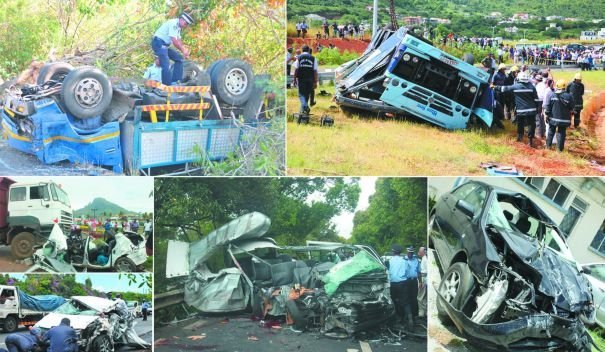Fatal Accidents: Human Error and Carelessness

According to police statistics, speeding, refusing to buckle her seat belt, double line on the right and follow a vehicle too closely and driving while intoxicated are the main causes of accidents. Note that 65 fatal accidents were recorded from January to date, an increase of 16.1% compared to the figures of last year.
Many accidents are caused by the carelessness of drivers on the road as well as human error. A very small percentage is still attributed to mechanical failure of vehicles.
Since the establishment of the system of penalty points in May, more than 2,000 motorists have been pinned for various offenses: use your phone while driving, speeding, failure to wear seat belts and helmets for the motorcycle, the non-observance of rules on the highway.
According to Inspector Veerasami the Traffic Branch, accidents on our roads can be avoided if each user whether motorist, motorcyclist, bus driver, pedestrian or driver of a heavy weight, assumes its share of responsibility and demonstrated discipline and prudence.
The fatal accidents can be avoided
Accidents on our roads can be avoided if everyone assumes its share of responsibility, says Inspector Veerasami the Traffic Branch. For example, he mentions the accident Tuesday morning in Bel-pond in which four people were killed. If the driver of the crashed car had taken the precaution of putting the disabled vehicle off the road, this deadly accident could have been avoided.
Scientifically speaking, lead to excessive speed in most cases help to return five minutes earlier at the intended destination but it is worth endangering the lives of his people and for those five minutes 'won' adds Inspector Veerasami.
He believes it would be a problem behavior road users and recklessness of drivers which are the causes of many fatal accidents on our roads. It recognizes that many accidents are related to a mechanical failure. These accidents can be avoided if the bus companies consider the maintenance of their vehicles as a first priority and regularly review any strategy requires as Road Safety Management.
At the police, more than 600 awareness courses were made last year, it is claimed to be central barracks. There are also elements of the Traffic Branch who work day and night to ensure that safety rules over our roads. At no time, we must believe that the road is deadly. This is not true. The truth is that we do not know to use, supports the inspector Veerasami. All roads are the same every day but this is the way we drive that makes the difference. Every day there are new challenges on our roads. But it is up to us to adapt to changing circumstances and to respond to unforeseen events. He wanted to add that road users must not only know the rules of the road, but must also be able to control the 'defensive driving' or to be more careful and to consider how to control his vehicle to avoid accidents.
The government will introduce very soon 'Driver's Education and Testing Centre'. The goal is to help aspiring drivers and automobile drivers of heavy vehicles. The police has already started in primary schools teaching pupils Standards IV and V. The idea is to teach these children to be good drivers disciplined in 10 or 15 years. In addition, drivers will in the not too distant future receive a 'License Vocational Course'.
For a senior official of the Ministry of Public Infrastructure and domestic transport of who wanted to remain anonymous, we must consider two things namely the behavior and performance of road users.
The behavior is related to everything that is considered education to improve the use of our roads, law enforcement and construction of public roads by engineers. Performance is explained as the ability of the driver or road user. The performance goes with the experience and how to handle the vehicle to avoid accidents.
According to the above framework, we tend to focus on the driving behavior to avoid accidents rather than improve performance drivers. Our roads have been built to an international standard. But the problem is: how do we engage to adapt.
On the other hand, another officer of the same department argues that it is time to innovate in technology to better locate the exact causes of accidents. We must have recourse to the accident simulation technical and recruit more engineers with a background in the Road Safety and Traffic Management. One might then expect to have more effective results.
The increasing number of vehicles on our roads prompt greater vigilance. The number is increasing year by year. In 2011, 400.919 vehicles traveling on our roads. In 2012 the figure rose to rose to 421.926 an increase of 21,007. In April 2013, the fleet of vehicles has increased to 428.877 an increase of 1.6%.
According Dharmarajen Mooroogen, the Police Public Relations Officer is of the opinion that the public do call for caution on the road. "It just enough to put his seat belt, not to violate the speed limit or driving while intoxicated to reduce the likelihood of accidents on our roads," he adds.
The police, he said, will continue to make its presence in areas at risk by conducting snap-check, speed controls and alcohol tests.
Related News


